Page 3 of 7
Mobility
It would appear that in draughts type games, greater freedom of movement grants a wider choice of action. This in itself does not necessarily make a game any more interesting, or we might be playing Draughts on a 20x20 board with 90 men per side. Since this looks just as advertising as playing on a 3x3 board with 3 men per side, we may safely conclude to the existence of an optimum boardsize for every draughts variant.
How large exactly a board should be is arguable: Spanish, International and Canadian all use the same rules, but on three different sizes. This does affect mobility because the ratio of all squares to squares on the edge increases (32/14 - 50/18 - 72/22). But creating greater freedom of choice by enlarging the playing area doesn't necessarily make the choices any more interesting.
In my opinion the games presented here all have a size that allows about all they have to offer to be made explicit with the minimum material required to do so. The size of the playing areas therefore will only be a criterion for mobility in relation to other criteria such as the number of men, the size of the promotion area and the direction and scope of movement of pieces. By the same argument Shaski will be represented by Draughts - its slightly higher mobility, due to absence of compulsory majority capture and a 'flying king', is counteracted to about the same degree by its smaller boardsize.
Checkers
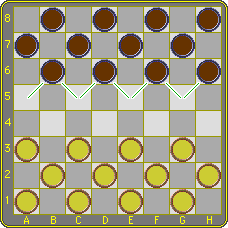
| number of | vacant | choice of | directions in which a man may: | ||
| squares | men per side | area | opening moves | move | capture |
| 32 | 12 | 25% | 7 | 2 | 2 |
| forced | promotion | average number of | range | directions in which a king may: | |
| progress | squares | moves to promotion | king | move | capture |
| yes | 4 | 6 | short | 4 | 4 |
This obviously doesn't look too impressive in terms of mobility. Marion Tinsley, the greatest Checkers player ever, described playing the game as 'looking into a bottomless pit'. It certainly may have looked that way, but among the top players a draw has become a very common result. A game is exhausted if nothing new can be found anymore and on top of that Chinook has the whole game wrapped up.
Draughts
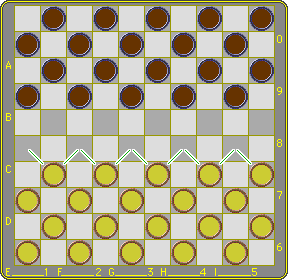
| number of | vacant | choice of | directions in which a man may: | ||
| squares | men per side | area | opening moves | move | capture |
| 50 | 20 | 20% | 9 | 2 | 4 |
| forced | promotion | average number of | range | directions in which a king may: | |
| progress | squares | moves to promotion | king | move | capture |
| yes | 5 | 7.5 | long | 4 | 4 |
Here piece mobility is higher due to backward capture and a long range king, but with only 20% of the board vacant things are fairly crammed in the opening. Promotion looks bad: only 5 squares and the men at an average distance of 7.5 moves.
Turkish
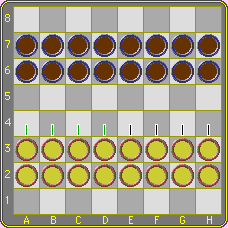
| number of | vacant | choice of | directions in which a man may: | ||
| squares | men per side | area | opening moves | move | capture |
| 64 | 16 | 50% | 8 (4) | 3 | 3 |
| forced | promotion | average number of | range | directions in which a king may: | |
| progress | squares | moves to promotion | king | move | capture |
| no | 8 | 5.5 | long | 4 | 4 |
The number of opening moves from here on is deceiving in that all next games have left-right symmetry in their opening array which effectively halves the number. However, symmetry is soon ends: in the square games, black on his first move already faces a non-symmetric situation.
Turkish Checkers' vacancy percentage is a bit flattered as an indicator of initial mobility: a player's own back rank hardly counts as part of his playing area.
Initial mobility looks somewhat meager because all sideways movement is blocked.
The game attracts some attention in the Draughts world in their quest to prove that Draughts isn't dying under their very eyes. They envy the two kings versus one endgame.
Armenian
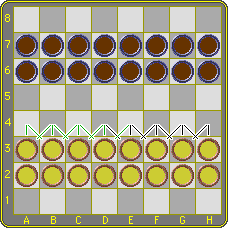
| number of | vacant | choice of | directions in which a man may: | ||
| squares | men per side | area | opening moves | move | capture |
| 64 | 16 | 50% | 22 (11) | 5 | 3 |
| forced | promotion | average number of | range | directions in which a king may: | |
| progress | squares | moves to promotion | king | move | capture |
| no | 8 | 5.5 | long | 8 | 4 |
Five directions of movement, three of capture and a supermobile king. This game offers flexibility and variety. The ratio in strength of a piece and a king may seem about the same as in Turkish draughts, but the king despite its increased mobility still can't capture a lone men.
Dameo
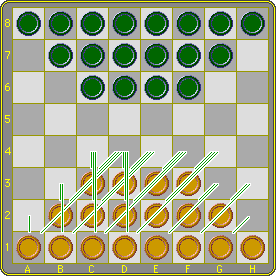
| number of | vacant | choice of | directions in which a man may: | ||
| cells | men per side | area | opening moves | move | capture |
| 64 | 18 | 44% | 52 (26) | 3 | 4 |
| forced | promotion | average number of | range | directions in which a king may: | |
| progress | cells | moves to promotion | king | move | capture |
| yes | 8 | 6.2 | long | 8 | 4 |
All rules and conventions concerning capture are the same as in Draughts, but applied to the straight plane. Movement however is linear: alingned pieces support rather than block one another. Though white's initial options are halved by left-right symmetry, the ones shown, black on his first move has 52 opening choices.
Piece mobility in general is extremely high: none of the other games offer such a degree of flexibility in tempo and pace. At the same time it is effectively restricted by forced progress and an abundance of tactical dangers.
Hexdame
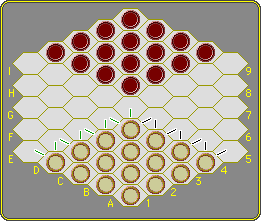
| number of | vacant | choice of | directions in which a man may: | ||
| cells | men per side | area | opening moves | move | capture |
| 61 | 16 | 48% | 15 (8) | 3 | 6 |
| forced | promotion | average number of | range | directions in which a king may: | |
| progress | cells | moves to promotion | king | move | capture |
| yes | 9 | 5.9 | long | 6 | 6 |
The 3-6 and 6-6 piece mobility is very high and so is the vacancy ratio, but here too mobility is effectively constrained by forced progress and tactical dangers.
A promotion area of 9 cells, pieces less than six moves away on average, no 1-on-1 opposition and an exeptionally strong king - this is very much a king's game.
Conclusion
Checkers
May we excuse Checkers? The game isn't designed for great mobility. It's the essential draughts type game and has great strategic depth, but its tactics and their scope cannot compete with any of the others. It is very much a game of a time gone by. Chinook has the game wrapped up and as a sport it's as dead as the dodo.
Draughts
Draughts obviously used to do better than Checkers, but things have changed. The game is fairly crammed in the opening and not very advertising in terms of room for promotion. It suffers most under its oblique plane: because it restricts its scope for tactics and increases the number of kings needed to capture a lone one to four.
Turkish and Armenian
Armenian tops the classix in terms of mobility: it superimposes the moves of men in the staight and the oblique plane. If the game is designed too improve on Turkish however, the intention may be better than the implementation. Despite its mobility it doesn't appear to operate more effectively. The need for such an archaic rule as declaring king versus man a win doesn't speak in favor of these games' favor.
Dameo
Dameo's linear movement is new to the game, yet the underlying logic is simple. It obviously accellerates the mechanism and offers a wider choice of pace and tempo. This might be an ideal game to replace Draughts as a sport weapon, but most draughts players shudder at the suggestion that anything might be wrong with their beloved game. Even after a century of widely discussed drawishness at top level, and countless suggested remedies.
Hexdame
In full recognition of the fact that a hexgrid may inspire some players to throw up, we nevertheless find a better scoresheet here than in the square game.
